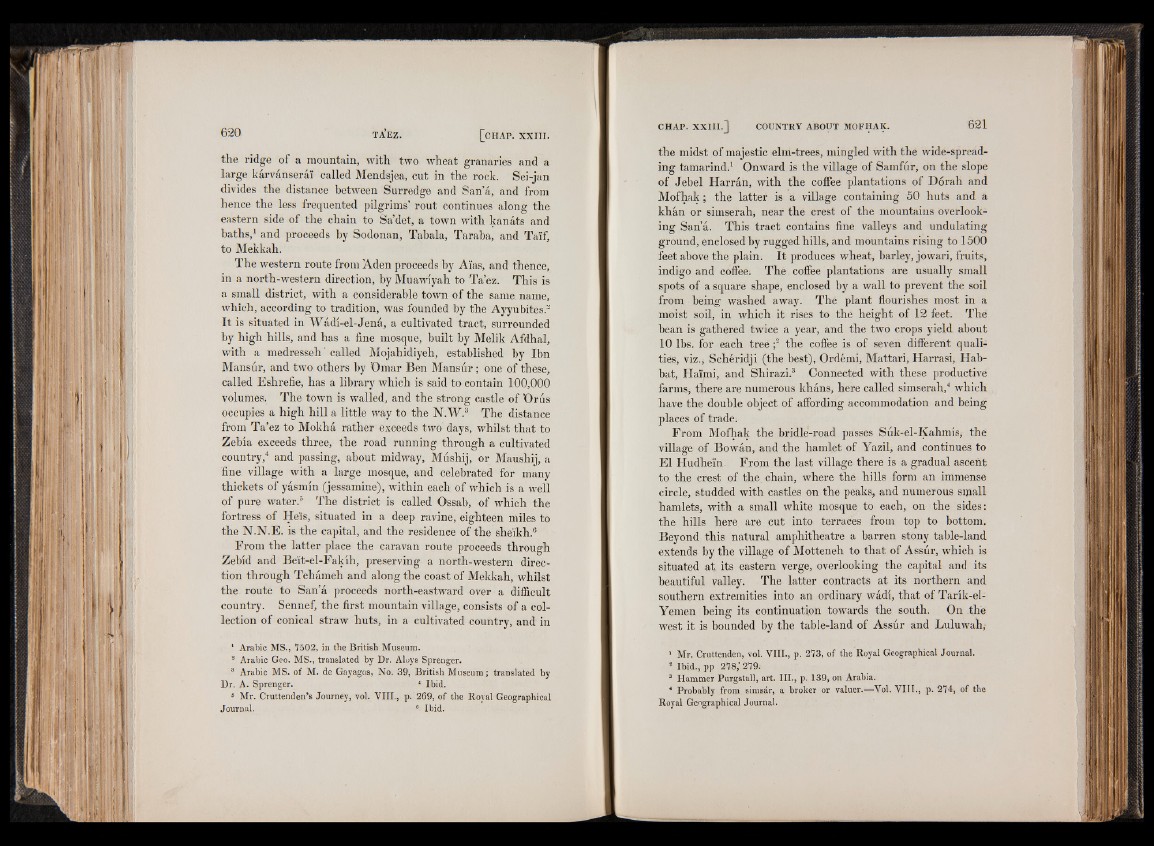
the ridge of a mountain, with two wheat granaries and a
large karvanserai called Mendsjea, cut in the rock. Sei-jan
divides the distance between Surredge and San’a, and from
hence the less frequented pilgrims’ rout continues along the
eastern side of the chain to Sa’det, a town with kanats and
baths,1 and proceeds by Sodonan, Tabala, Taraba, and Tai'f,
to Mekkah.
The western route from Aden proceeds by Aias, and thence,
in a north-western direction, by Muawiyah to Ta’ez. This is
a small district, with a considerable town of the same, name,
which, according to tradition, was founded by the Ayyubites.3
It is situated in Wadi-el-Jena, a cultivated tract, surrounded
by high hills, and has a fine mosque, built by Melik Afdhal,
with a medresseh' called Mojahidiyeh, established by Ibn
Mansur, and two others by ’Omar Ben Mansur; one of these,
called Eshrefie, has a library which is said to contain 100,000
volumes. The town is walled, and the strong castle of Orus
occupies a high hill a little way to the N.W.3 The distance
from Ta’ez to Mokha rather exceeds two days, whilst that to
Zebia exceeds three, the road running through a cultivated
country,4 and passing, about midway, Mushij, or Maushij, a
fine village with a large mosque, and celebrated for many
thickets of yasmin (jessamine), within each of which is a well
of pure water.5 The district is called Ossab, of which the
fortress of Hei's, situated in a deep ravine, eighteen miles to
the N.N.E. is the capital, and the residence of the sheikh.6
From the latter place the caravan route proceeds through
Zebid and Be'it-el-Fakih, preserving a north-western direction
through Tehameh and along the coast of Mekkah, whilst
the route to San’a proceeds north-eastw'ard over a difficult
country. Sennef, the first mountain village, consists of a collection
of conical straw huts, in a cultivated country, and in
1 Arabic MS., 1502, in tbe British Museum.
2 Arabic Geo. MS., trauslated by Dr. Aloys Sprenger.
3 Arabic MS. of M. de Gayagos, No. 39, British Museum; translated by
Dr. A. Sprenger. 4 Ibid.
s Mr. Cruttenden’s Journey, vol. VIII., p. 269, of the Royal Geographical
Journal. ’ Ibid.
the midst of majestic elm-trees, mingled with the wide-spreading
tamarind.1 Onward is the village of Samfur, on the slope
of Jebel Harran, with the coffee plantations of Dorah and
Mofhak ; the latter is a village containing 50 huts and a
khan or simserah, near the crest of the mountains overlooking
San’a. This tract contains fine valleys and undulating
ground, enclosed by rugged hills, and mountains rising to 1500
feet above the plain. It produces wheat, barley, jowari, fruits,
indigo and coffee: The coffee plantations are usually small
spots of a square shape, enclosed by a wall to prevent the soil
from being washed away. Thé plant flourishes most in a
moist soil, in which it rises to the height of 12 feet. The
hean is gathered twice a year, and the two crops yield about
10 lbs. for each tree f the coffee is of seven different qualities,
viz., Schéridji (the best), Ordémi, Mattari, Harrasi, Hab-
bat, Haïmi, and Shirazi.3 Connected with these productive
farms; there are numerous khans, here called simserah,4 which
have the double object of affording accommodation and being
places of trade.
From Mofhak the bridle-road passes Suk-el-Kahmis, the
village of Bo wan, and the hamlet of Yazil, and continues to
El Hudheïn. From the last village there is a gradual ascent
to the crest of the. chain, where the hills form an immense
circle, studded with castles on the peaks, and numerous sipall
hamlets, with a small white mosque to each, on the sides:
the hills here are cut into terraces from top to bottom.
Beyond this natural amphitheatre a barren stony table-land
extends by the village of Motteneh to that of Assur, which is
situated at its eastern verge, overlooking the capital and its
beautiful valley. The latter contracts at its northern and
southern extremities into an ordinary wadi, that of Tarik-el-
Yemen being its continuation towards the south. On the
west it is bounded by the table-land of Assur and Luluwah,
1 Mr. Cruttenden, vol. VIII., p. 213, of the Royal Geographical Journal.
2 Ibid., pp 278,' 279:
3 Hammer Purgstall, art. III., p. 139, on Arabia.
4 Probably from simsdr, a broker or valuer.—Vol. VIII., p. 274, of the
Royal Geographical Journal.